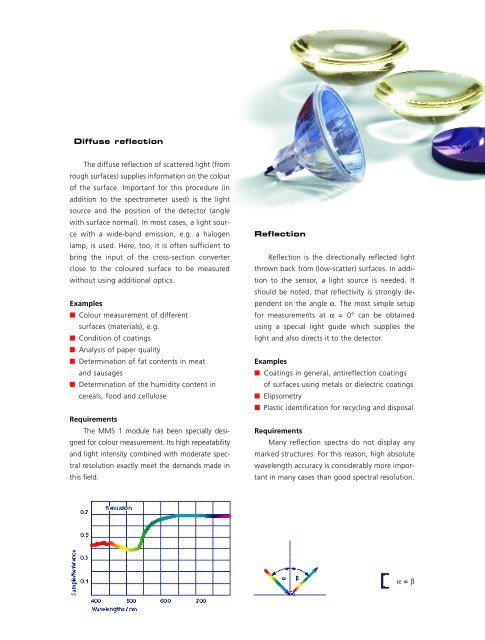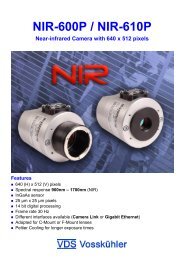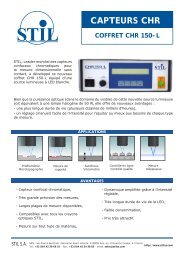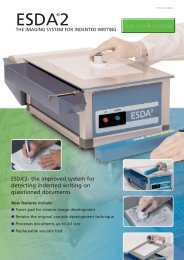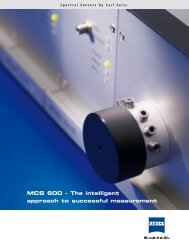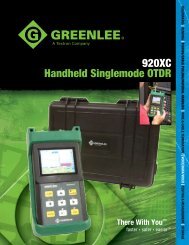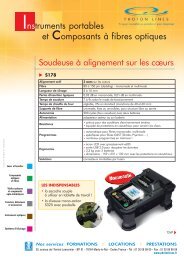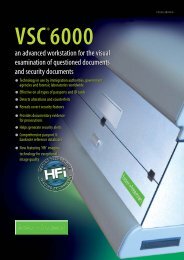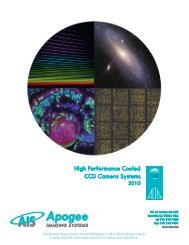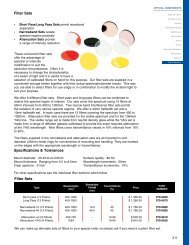MMS â Monolithic M i n i a t u re - S p e c t ro m e t e r - Photon Lines
MMS â Monolithic M i n i a t u re - S p e c t ro m e t e r - Photon Lines
MMS â Monolithic M i n i a t u re - S p e c t ro m e t e r - Photon Lines
You also want an ePaper? Increase the reach of your titles
YUMPU automatically turns print PDFs into web optimized ePapers that Google loves.
D i ffuse <st<strong>ro</strong>ng>re</st<strong>ro</strong>ng> f l e c t i o nThe diffuse <st<strong>ro</strong>ng>re</st<strong>ro</strong>ng>flection of scatte<st<strong>ro</strong>ng>re</st<strong>ro</strong>ng>d light (f<strong>ro</strong> m<strong>ro</strong>ugh surfaces) supplies information on the colou<strong>ro</strong>f the surface. Important for this p<strong>ro</strong> c e d u <st<strong>ro</strong>ng>re</st<strong>ro</strong>ng> (inaddition to the spect<strong>ro</strong>meter used) is the lights o u rce and the position of the detector (anglewith surface normal). In most cases, a light sourcewith a wide-band emission, e.g. a halogenlamp, is used. He<st<strong>ro</strong>ng>re</st<strong>ro</strong>ng>, too, it is often sufficient tobring the input of the c<strong>ro</strong>ss-section convert e rclose to the colou<st<strong>ro</strong>ng>re</st<strong>ro</strong>ng>d surface to be measu<st<strong>ro</strong>ng>re</st<strong>ro</strong>ng> dwithout using additional optics.Examples■ Colour measu<st<strong>ro</strong>ng>re</st<strong>ro</strong>ng>ment of diff e <st<strong>ro</strong>ng>re</st<strong>ro</strong>ng>nts u rfaces (materials), e.g.■ Condition of coatings■ Analysis of paper quality■ D e t e rmination of fat contents in meatand sausages■ D e t e rmination of the humidity content inc e <st<strong>ro</strong>ng>re</st<strong>ro</strong>ng>als, food and celluloseRequi<st<strong>ro</strong>ng>re</st<strong>ro</strong>ng>mentsThe <st<strong>ro</strong>ng>MMS</st<strong>ro</strong>ng> 1 module has been specially designedfor colour measu<st<strong>ro</strong>ng>re</st<strong>ro</strong>ng>ment. Its high <st<strong>ro</strong>ng>re</st<strong>ro</strong>ng>peatabilityand light intensity combined with moderate spectral<st<strong>ro</strong>ng>re</st<strong>ro</strong>ng>solution exactly meet the demands made inthis fie l d .R e f l e c t i o nReflection is the di<st<strong>ro</strong>ng>re</st<strong>ro</strong>ng>ctionally <st<strong>ro</strong>ng>re</st<strong>ro</strong>ng>flected lightt h <strong>ro</strong>wn back f<strong>ro</strong>m (low-scatter) surfaces. In additionto the sensor, a light source is needed. ltshould be noted, that <st<strong>ro</strong>ng>re</st<strong>ro</strong>ng>flectivity is st<strong>ro</strong>ngly dependenton the angle α. The most simple setupfor measu<st<strong>ro</strong>ng>re</st<strong>ro</strong>ng>ments at α = 0° can be obtainedusing a special light guide which supplies thelight and also di<st<strong>ro</strong>ng>re</st<strong>ro</strong>ng>cts it to the detector.Examples■ Coatings in general, anti<st<strong>ro</strong>ng>re</st<strong>ro</strong>ng>flection coatingsof surfaces using metals or dielectric coatings■ E l i p s o m e t ry■ Plastic identification for <st<strong>ro</strong>ng>re</st<strong>ro</strong>ng>cycling and disposalRequi<st<strong>ro</strong>ng>re</st<strong>ro</strong>ng>mentsMany <st<strong>ro</strong>ng>re</st<strong>ro</strong>ng>flection spectra do not display anymarked stru c t u <st<strong>ro</strong>ng>re</st<strong>ro</strong>ng>s. For this <st<strong>ro</strong>ng>re</st<strong>ro</strong>ng>ason, high absolutewavelength accuracy is considerably mo<st<strong>ro</strong>ng>re</st<strong>ro</strong>ng> importantin many cases than good spectral <st<strong>ro</strong>ng>re</st<strong>ro</strong>ng> s o l u t i o n .α = β


